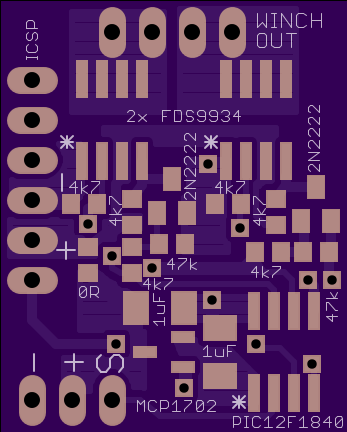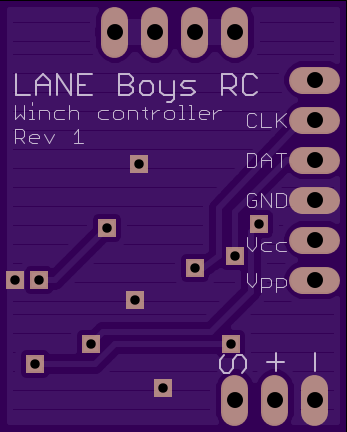This project is for a winch controller for Radio Controlled cars that uses channel 3 to operate the winch remotely.
Connect the winch controller to channel 3 of your receiver.
Three seconds after you apply power to the controller the winch motor will play a short tune. The sound will only play if a valid input signal has been detected. Note that the sound generated by the motor may be very faint depending on your winch.
To arm the switch, change the position of the channel 3 switch on your transmitter five times within a short period of times. The winch motor will now play a different tune of rising sounds indicatiting that it is armed. While armed, the winch motor will be braked electrically.
To move the winch in one direction, change the position of the channel 3 switch once. To move the winch in the other direction, change the position of the channel 3 switch twice within a short time.
To stop the winch moving toggle the position of the channel 3 switch.
The winch hardware is basically a H-bridge motor driver controlled from a tiny microcontroller.
The winch controller can be powered via the RC receiver, or from a separate supply connected to the pins labeled + an - on the ICSP connector.
The main components are a Microchip PIC 12F1840 microcontroller, two dual N- and P-Channel power FETs Fairchild FDS9934C, and a 3.3V LDO (Microchip MCP1702, 1703 or similar).
A common 1/10th scale RC winch can lift about 1.5 kg at 6 Volts. The maxium current we measured on our winch is 800 mA.
The schematics and a PCB layout are available in the electronics folder.
Bill of material:
Qty Value Device Parts 1 PIC12F1840 PIC12F1840 S08 U$2 2 FDS9934 P/N MOSFET SO8 T1, T2 1 MCP1702-3302 LDO 3V3 SOT23 U$1 2 MMTB2222 NPN-TRANSISTOR SOT23 Q1, Q2 2 1uF/16V Capacitor SMD 1206 C1, C2 1 0R Resistor SMD 0603 R9 (can be replced with a solder bridge) 6 4k7 Resistor SMD 0603 R1, R2, R3, R4, R7, R8 2 47k Resistor SMD 0603 R5, R6
The 2-layer PCB size is 22.05 x 27.43 mm (0.87 x 1.08 inches).
Gerber files for the PCB can be found in the electronics folder. The PCB can be ordered directly from OSHPark in a minimum quantity of three.
The firmware has been developed using SDCC version 3.3 and gpasm version 1.0. GNU make is required for the build.
If you are compiling the software on a computer that does not have Unix-like tools installed (e.g. Microsoft Windows) then you may need to adapt the rm utility referenced in the Makefile (i.e. use "del" instead of "rm").
For convenience a pre-compiled HEX file is available for download here.
The firmware comes in two variants: One that connects to channel 3 of a RC receiver, and one with UART input which is meant to be utilized in conjunction with the LANE Boys RC DIY RC Light controller.

